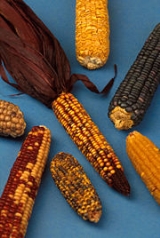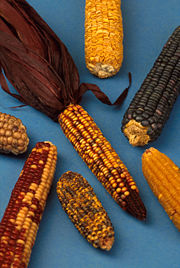
Corncob
Encyclopedia


Maize
Maize known in many English-speaking countries as corn or mielie/mealie, is a grain domesticated by indigenous peoples in Mesoamerica in prehistoric times. The leafy stalk produces ears which contain seeds called kernels. Though technically a grain, maize kernels are used in cooking as a vegetable...
(Zea mays ssp. mays L.) ear.
The corn plant's ear
Ear (botany)
An ear is the grain-bearing tip part of the stem of a cereal plant, such as wheat or maize. It can also refer to "a prominent lobe in some leaves".The ear is a spike, consisting of a central stem on which grows tightly packed rows of flowers...
is also considered a "cob" or "pole" but it is not fully a "pole" until the ear is shucked, or removed from the plant material around the ear. Every row of corn on a corncob has the same number of kernels.
Young ears, also called baby corn, can be consumed raw, but as the plant matures the cob becomes tougher until only the kernels are edible. When harvesting corn the corncob may be collected as part of the ear or may be left as part of the corn stover
Corn stover
Corn stover consists of the leaves and stalks of maize plants left in a field after harvest and consists of the residue: stalk; the leaf, husk, and cob remaining in the field following the harvest of cereal grain.” Stover makes up about half of the yield of a crop and is similar to straw...
in the field.
Uses
Corncobs find use in the following applications:- Industrial source of the chemical furfuralFurfuralFurfural is an organic compound derived from a variety of agricultural byproducts, including corncobs, oat, wheat bran, and sawdust. The name furfural comes from the Latin word , meaning bran, referring to its usual source....
- Fiber in fodderFodderFodder or animal feed is any agricultural foodstuff used specifically to feed domesticated livestock such as cattle, goats, sheep, horses, chickens and pigs. Most animal feed is from plants but some is of animal origin...
for ruminantRuminantA ruminant is a mammal of the order Artiodactyla that digests plant-based food by initially softening it within the animal's first compartment of the stomach, principally through bacterial actions, then regurgitating the semi-digested mass, now known as cud, and chewing it again...
livestock (despite low nutritional value) - Raw material for bowls of corncob pipes
- CharcoalCharcoalCharcoal is the dark grey residue consisting of carbon, and any remaining ash, obtained by removing water and other volatile constituents from animal and vegetation substances. Charcoal is usually produced by slow pyrolysis, the heating of wood or other substances in the absence of oxygen...
production
Corncob is also commonly used as bedding
Bedding
Bedding refers to the materials laid above the mattress of a bed for hygiene, warmth, to protect the mattress, and for decorative effect. Bedding is the removable and washable portion of a human sleeping environment. It is more easily and economically replaced than the bed itself...
for rodents used as subjects in research experiments, usually supplemented with other types of bedding like cotton
Cotton
Cotton is a soft, fluffy staple fiber that grows in a boll, or protective capsule, around the seeds of cotton plants of the genus Gossypium. The fiber is almost pure cellulose. The botanical purpose of cotton fiber is to aid in seed dispersal....
fiber intended to reduce respiratory
problems blamed in turn on all-corncob bedding and bacterial growth.

